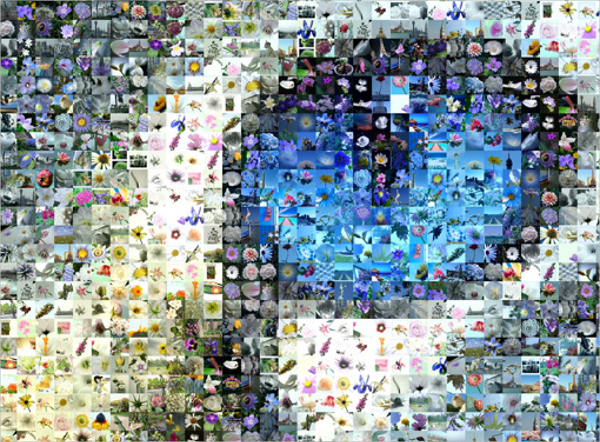

There is debate over whether Photomosaics are an art or mere technique. 1995 Robert Silvers creates an algorithm for generating Photomosaics programmatically and goes on to trademark the term Photomosaic and patent his process for creation of Photomosaics in 1997.1995 Adam Finkelstein (published mosaic in Mossy Bits) creates a mosaic of the 1930 oil painting by Grant Wood, American Gothic, from images collected from the Web in early 1995.This was the first large photographic mosaic, using photographs of 10,062 people from 110 countries to make the Mona Lisa. 1995 The Gioconda Sapiens, a face with ten thousand faces, was presented to the public in April 1995 (Spain, Domus museum).Over one thousand young peoples' portraits from all over the word computer-processed spell out the word AIDS. The result was displayed in the Xerox PARC Algorithmic Art Show in 1994. Kennedy from parts of Marilyn Monroe pictures. 1994 Adam Finkelstein and Sandy Farrier create a mosaic of John F.1994 Dave McKean creates an image for DC Comics, a mosaic of a face made from photos of faces, although this is believed to be created manually using Photoshop.Francis has said on his "History of Photo Mosaics" webpage that his interest in developing these techniques further was in part stimulated by the work of artist Chuck Close. He went on to create a mosaic for Animation Magazine in 1993, which was repeated in Wired Magazine (November 1994, p. 106). His Live from Bell Labs poster created in 1993 used computer-themed tile photographs to create a mosaic of a face ( Ryszard Horowitz/ Photography and Art Direction, Robert Bowen/ Digital Artist). 1993 Joseph Francis, working for R/Greenberg Associates in Manhattan, is believed to be the inventor of the modern-day computer-generated colour image versions.The name Photomosaic and an implementation concept were trademarked by Robert Silvers' Runaway Technology, Inc. Space scientists have been assembling mosaics of this kind since at least as early as the Soviet satellite missions to the Moon in the late 1950s.
#Photo mosaic video series
Originally, the term photomosaic referred to compound photographs created by stitching together a series of adjacent pictures of a scene. This requires much more computation than the simple kind, but the results can be much better since the pixel-by-pixel matching can preserve the resolution of the target image. The rectangle in the target is then replaced with the library image that minimizes the total difference. In the more advanced kind of photographic mosaic, the target image is not downsampled, and the matching is done by comparing each pixel in the rectangle to the corresponding pixel from each library image. In effect, the target image is reduced in resolution (by downsampling), and then each of the resulting pixels is replaced with an image whose average color matches that pixel. Each part of the target image is then replaced with one from the library where these colors are as similar as possible. Each of the library images is also reduced to a single color. In the simpler kind, each part of the target image is averaged down to a single color. There are two kinds of mosaic, depending on how the matching is done. Most of the time they are a computer-created type of montage. When viewed at low magnifications, the individual pixels appear as the primary image, while close examination reveals that the image is in fact made up of many hundreds or thousands of smaller images.

In the field of photographic imaging, a photographic mosaic, also known under the term Photomosaic, is a picture (usually a photograph) that has been divided into (usually equal sized) tiled sections, each of which is replaced with another photograph that matches the target photo.

A photographic mosaic of a sea gull made from pictures of birds and other nature photos using hexagonal tiles


 0 kommentar(er)
0 kommentar(er)
